Some of the most common problems with foundation include makeup moving around, “sliding off” and separation, especially around the t-zone. It’s probably the most common question I get asked about complexion. I was thinking about all of the advice I give and thought I would collate this in a blog post for those interested.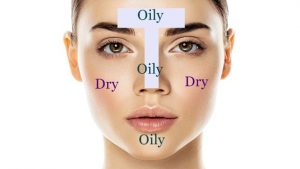
- First of all, good complexions are born from good skincare.
- Good skincare starts with staying hydrated.
- Good skin is maintained by cleaning your face AM and PM.
- Skin is altered or problem-solved by specific ingredients.
- Good skin is maintained by cleaning your face AM and PM.
- Good skincare starts with staying hydrated.
So after the mini crash course in skincare, there is actually one more thing that can be affecting your complexion. Most people are usually driven to buy primers and foundations because of an advert, a recommendation or a celebrity endorsement. However, understanding how primers and foundations work together could really change the way you select your products.
- Water Based Primers + Water Based Foundations = Great for dry skin and sensitive skin. Also good for those who are prone to breakouts.
- Silicone Based Primers + Silicone Based Foundations = Great for oily skin.
- Water Based Primers + Silicone Foundations = Will probably look okay straight after application, but throughout the day the two will repel each other, causing your makeup to slide off.
- Silicone Based Primers + Water Based Foundations = Will cause separation. The primer will create a silicone barrier which repels the water in the foundation not letting it absorb properly into your skin, resulting in unevenness.
Not only should you use a combination that works for your skin type, you should also be pairing them, like for like. Mis-matching brands are fine as long as they both belong to the same category ‘water based’ or ‘silicone based’.
So, how do we know what’s what? We look at the ingredients!!
-Cone/-methicone and -siloxane words near the top of the list tend to signal a silicone-based product. Although water may be at the top of an ingredient list, it doesn’t necessarily mean that the product is water based. Products can be silicone based even if water is at the top of the ingredient list because water is what’s needed to make a “liquid product”.
Here is an example of an ingredient list for a silicone based primer: Touch In Sol No Problem Primer
Cyclopentasiloxane, Water, Dimethicone, Dimethicone/Vinyl Dimethicone, Crosspolymer, PEG-10 Dimethicone, Dimethicone Crosspolymer, Dipropylene Glycol, Silica, Phenoxyethanol, Disteardimonium Hectorite, Magnesium Sulfate, Fragance(Parfum), Methyl Methacrylate Crosspolymer, Titanium Dioxide (CI 77891), Ethylhexylglycerin, Disodium EDTA, Aluminum Hydroxide, Stearic Acid, Butylene Glycol, Iron Oxides (CI 77491), Soluble Collagen, Red 30 Lake (CI 73360), Camellia Sinensis Leaf Extract, Triethoxycaprylylsilane.
I’ve made the silicone-based ingredients bold so that you can see the primary ingredients are silicone based, therefore making this a silicone based primer.
Here is an example an ingredient list for a water based primer: MILK Makeup Hydro Grip Primer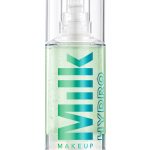
Aloe Barbadensis Leaf Water, Water, Glycerin, PEG-150 Distearate, Alcohol Denat., Polyglyceryl-10 Eicosanedioate/Tetradecanedioate, Diglycerin, PVP, Benzyl Alcohol, Sorbitol, Pullulan, Inositol, Betaine, Carbomer, Maltose, Xylitol, Sodium Hydroxide, Sodium Benzoate, Potassium Sorbate, Sodium Phytate, Benzophenone-4, Dehydroacetic Acid, Phenoxyethanol, Agave Tequilana Stem Extract, Sodium Hyaluronate, Niacinamide, Propylene Glycol, Panthenol, Vegetable Amino Acids, Cannabis Sativa (Hemp) Seed Extract, Opuntia Ficus-Indica Flower Extract, Prunus Avium Flower Extract, Citric Acid, Benzoic Acid, Yellow 5 (Ci 19140), Blue 1 (Ci 42090), Red 33 (Ci 17200).
As you can see there aren’t any silicone ingredients on the top of this list (if any) which means it’s a water-based primer.
Here is an example of an ingredient list for a Silicone Based Foundation: NARS Natural Radiant Longwear Foundation
Dimethicone, Water, Phenyl Trimethicone, Glycerin, Polymethylsilsesquioxane, Peg-10 Dimethicone, Dimethicone Crosspolymer, Cyclopentasiloxane, Trimethylsiloxysilicate, Ppg-3 Benzyl Ether Myristate, Boron Nitride, Bis-Butyldimethicone Polyglyceryl-3, Butylene Glycol, Sorbitan Sesquiisostearate, Rubus Idaeus (Raspberry) Fruit Extract, Citrullus Lanatus (Watermelon) Fruit Extract, Pyrus Malus (Apple) Fruit Extract, Lens Esculenta (Lentil) Fruit Extract, Tocopherol, Sodium Pca, Sodium Lactate, Disodium Stearoyl Glutamate, Hydrogenated Polydecene, Pentaerythrityl Tetraethylhexanoate, Peg/Ppg-14/7 Dimethyl Ether, Pentaerythrityl Tetra-Di-T-Butyl Hydroxyhydrocinnamate, Sodium Stearoyl Glutamate, Behenic Acid, Stearic Acid, Stearyl Alcohol, Behenyl Alcohol, Disteardimonium Hectorite, Triethoxycaprylylsilane, Barium Sulfate, Aluminum Dimyristate, Alumina, Tin Oxide, Polysilicone-2, Potassium Hydroxide, Phenoxyethanol, Sodium Benzoate, Potassium Sorbate, [+/- (May Contain): Mica, Titanium Dioxide (Ci 77891), Iron Oxides (Ci 77491), Iron Oxides (Ci 77492), Iron Oxides (Ci 77499)].
You can see in bold the primary ingredients are silicone based, making this a silicone based foundation.
Here is an example of an ingredient list for a Water-Based Foundation that is one of my favourites: Too Faced Born This Way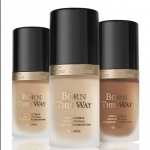 Foundation
Foundation
Water, Cyclopentasiloxane, Glycerin, Aluminum Starch Octenylsuccinate, Isododecane, Polyglyceryl-4 Isostearate, Cetyl PEG/PPG-10/1 Dimethicone, Hexyl Laurate, Dimethicone, Ethylhexyl Methoxycinnamate, Magnesium Sulfate, Diphenyl Dimethicone, Tribehenin, Triethoxycaprylylsilane, Disteardimonium Hectorite, Polysilicone-11, Propylene Carbonate, Tetrahexyldecyl Ascorbate, Cocos Nucifera Water, Ethylhexyl Palmitate, Rhododendron Ferrugineum Extract, Alcohol, Silica Dimethyl Silylate, Llyl Glycol, Phenoxyethanol. May Contain (+/-): Titanium Dioxide (CI 77891), Iron Oxides (CI 77491, CI 77492, CI 77499).
You can see in bold there are some silicone ingredients in there, however they are not the primary ingredients therefore making this foundation a water based foundation.
Water-Based Foundations
Water-based foundations will contain neither oil nor silicone at the top of their ingredient lists. Some water-based foundations may have silicones in them, but the quantity is so small that it isn’t worth mentioning.
If you’re prone to breakouts, a water-based foundation will be the most gentle on your skin. This is also a great option for dry skin because these formulas tend to be nourishing and packed with skin-loving ingredients to help maintain a moisturized look.
Silicone-Based Foundations
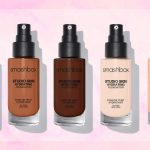 If your foundation is silicone-based, it will (usually) contain ingredients ending in -cone, -methicone and -siloxane as the second or third ingredient. The first ingredient will most likely be water, but that doesn’t mean the foundation is water-based.
If your foundation is silicone-based, it will (usually) contain ingredients ending in -cone, -methicone and -siloxane as the second or third ingredient. The first ingredient will most likely be water, but that doesn’t mean the foundation is water-based.
These foundations are great for mattifying and controlling shine — it’s like having a primer built into your foundation. Because of their mattifying effect, silicone-based primers are good for oily skin. They prolong the longevity of your makeup and protect your skin from outside elements.
Now that you know the importance of identifying a water-based product from a silicone-based product, you can get to work on pairing your foundations with the right primers. This isn’t to say that a silicone primer could never work with a water based foundation or vice versa, but it’s not recommended and you’ll most likely have better and longer lasting results if your bases are the same.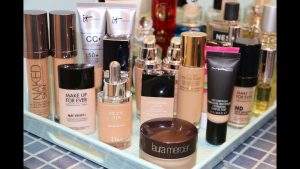
You may also need to test products out to figure out which work best with your skin type. Once you’ve decided what base will work best for you (water based or silicone based), then you can narrow down your search when choosing a foundation and primer. It may be worth investigating your concealers as well to see if they are lending themselves to one team or another.
I hope this was helpful in solving some of your dreaded makeup complexion problems. I know it’s annoying to have to add another step to your “makeup-buying process” but it’ll be worth it if you’re looking for a makeup application that will look great and last all day. You can always bookmark this page as a reference when you go shopping, that should help too.
Here are some of my favorite Water-Based foundations:
- Born This Way Foundation • Too Faced • £29 [FAV]
- Traceless Foundation Stick • Tom Ford • £66
- Flex Foundation Stick • Milk Makeup • £32
- Stay Naked Weightless Foundation • Urban Decay • £31
- Blur Liquid Matte Foundation • Milk Makeup • £35
- #FauxFilter Foundation • HUDA BEAUTY • £34 [FAV]
Here are some Water-Based Primers
- Pure Canvas Primer Hydrating • Laura Mercier • £34
- Blurring Pure Canvas Primer • Laura Mercier • £34
- Pure Canvas Primer Illuminating • Laura Mercier • £34
- Hangover Replenishing Face Primer • Too Faced • £12 [FAV]
- Hydro Grip Primer • Milk Makeup • £13
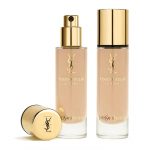 Here are some of my favorite Silicone-Based Foundations
Here are some of my favorite Silicone-Based Foundations
- Touche Éclat Le Teint • YSL • £36 [ALLTIME FAV]
- Studio Skin Hydrating • Smashbox • £30 [FAV]
- Natural Radiant Longwear Foundation • NARS • £37
- Luminous Silk Foundation • Giorgio Armani • £44 [FAV]
- Sheer Glow Foundation • NARS • £35
- Skin Love Weightless Blur Foundation • Becca • £32 [FAV]
- Dior Diorskin Forever Undercover 24-Hour Full Coverage Foundation • Christian Dior • £37
Here are some of my favorite Silicone-Based Primers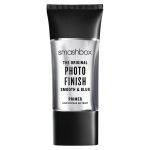
- Touche Éclat Blur Primer • YSL • £32 [FAV]
- Radiance Primer SPF 35 • NARS • £29
- Touch In Sol – No Poreblem Primer • £14.50
- Primed & Poreless Face Primer • Too Faced • £26
- The Original Photo Finish Smooth and Blur Primer • Smashbox • £29 [FAV]
- Photo Finish Oil and Shine Control Primer • Smashbox • £28
- Pro Filt’r Hydrating Primer • Fenty Beauty By Rihanna • £24 [FAV]
 Patchy makeup that separates on your skin is such a common problem! I hear so many people telling me that foundation ‘doesn’t work’ for them or ‘doesn’t look right’ on them. This inconsistent coverage is a result of
Patchy makeup that separates on your skin is such a common problem! I hear so many people telling me that foundation ‘doesn’t work’ for them or ‘doesn’t look right’ on them. This inconsistent coverage is a result of 
 You know how you can often look better in the
You know how you can often look better in the 

 take care of your skin after sun exposure without leaving you feeling oily. A personal favorite is an ultra-moisturising after-sun ‘Rescue Balm’ from Clinique, which contains aloe to help soothe sun-exposed skin. It also helps to reduce the look of peeling after sun exposure. It’s
take care of your skin after sun exposure without leaving you feeling oily. A personal favorite is an ultra-moisturising after-sun ‘Rescue Balm’ from Clinique, which contains aloe to help soothe sun-exposed skin. It also helps to reduce the look of peeling after sun exposure. It’s  suitable for face and body, plus the balm is oil-free and non-acnegenic. Please don’t skip this step in a bid for a matte complexion, as your skin will need a drink after being out in the sun all day. There are several cooling, mattifying gels available to help reduce shine. These can be layered on top of an oil-free moisturizer or after sun. The best I’ve come across is Benefit’s Porefessional Matte Rescue.
suitable for face and body, plus the balm is oil-free and non-acnegenic. Please don’t skip this step in a bid for a matte complexion, as your skin will need a drink after being out in the sun all day. There are several cooling, mattifying gels available to help reduce shine. These can be layered on top of an oil-free moisturizer or after sun. The best I’ve come across is Benefit’s Porefessional Matte Rescue. That brings me onto the next ‘go to’ product that will make all the difference. Benefit’s Porefessional primer. This product is like poly-filler, making every fine line, pore or blemish instantly smoothed out. This is a great option for every skin type and will also look great when worn alone. It has no colour, so if you are someone who doesn’t wear a lot of foundation, (or none at all whilst on holiday), look no further than this product for your base.
That brings me onto the next ‘go to’ product that will make all the difference. Benefit’s Porefessional primer. This product is like poly-filler, making every fine line, pore or blemish instantly smoothed out. This is a great option for every skin type and will also look great when worn alone. It has no colour, so if you are someone who doesn’t wear a lot of foundation, (or none at all whilst on holiday), look no further than this product for your base. The quick fix for this is liquid foundation and liquid bronzer. Taking a liquid bronzer or a product equivalent will enable you to darken your foundation day by day as your tan deepens in colour. Benefit’s ‘Dew the Hoola’ does a wonderful job of illuminating your skin whilst deepening the colour. This can be mixed in with your foundation, added on top of foundation, or worn alone to give you an instant tan with sheer coverage. Using this with a large synthetic ‘buffing’ brush is the best way for even application.
The quick fix for this is liquid foundation and liquid bronzer. Taking a liquid bronzer or a product equivalent will enable you to darken your foundation day by day as your tan deepens in colour. Benefit’s ‘Dew the Hoola’ does a wonderful job of illuminating your skin whilst deepening the colour. This can be mixed in with your foundation, added on top of foundation, or worn alone to give you an instant tan with sheer coverage. Using this with a large synthetic ‘buffing’ brush is the best way for even application. My recommendations for eye shadow bases are…
My recommendations for eye shadow bases are…  Smashbox’s 24hr Primer for eye shadow beginners and P Louise Base for intermediate to advanced eye shadow artists. Below is an example of how this product helps your eye shadow application and staying powder.
Smashbox’s 24hr Primer for eye shadow beginners and P Louise Base for intermediate to advanced eye shadow artists. Below is an example of how this product helps your eye shadow application and staying powder.


 premature ageing. Ever heard the phrase prevention is better than cure? Well in this case it’s cheaper too! Anti-ageing products don’t come cheap and a very small percentage of them are proven to be effective.
premature ageing. Ever heard the phrase prevention is better than cure? Well in this case it’s cheaper too! Anti-ageing products don’t come cheap and a very small percentage of them are proven to be effective.

 little time for grooming. Not suitable for dry, dehydrated or mature skin. I recommend Smashbox Camera Ready BB Cream.
little time for grooming. Not suitable for dry, dehydrated or mature skin. I recommend Smashbox Camera Ready BB Cream. summertime, holidays, and casual wear. Not suitable for severely blemished skin or uneven skin tones. I recommend Laura Mercier oil-free Tinted Moisturiser.
summertime, holidays, and casual wear. Not suitable for severely blemished skin or uneven skin tones. I recommend Laura Mercier oil-free Tinted Moisturiser. 
 For a fuller coverage foundation and staying power for nights out, I recommend Smashbox Studio Skin, which also comes in a refreshingly large variety of shades.
For a fuller coverage foundation and staying power for nights out, I recommend Smashbox Studio Skin, which also comes in a refreshingly large variety of shades.





 for those with acne or oily skin. If an ingredient is comedogenic, it will encourage blocked pores and the formation of black heads. Traditional gold-standard testing for comedogenicity was carried out on rabbit ears. Chemical ingredients were simply applied to the rabbit’s ears and scientists would look to see if comedones or blackheads developed. Many cosmetic scientists and dermatologists felt it was inaccurate and misleading and many influential dermatologists later discredited its use. The EU has now banned animal testing and comedogenicity test commonly take place on humans.
for those with acne or oily skin. If an ingredient is comedogenic, it will encourage blocked pores and the formation of black heads. Traditional gold-standard testing for comedogenicity was carried out on rabbit ears. Chemical ingredients were simply applied to the rabbit’s ears and scientists would look to see if comedones or blackheads developed. Many cosmetic scientists and dermatologists felt it was inaccurate and misleading and many influential dermatologists later discredited its use. The EU has now banned animal testing and comedogenicity test commonly take place on humans. “Clinically proven: This means it is almost NEVER a robust clinical trial with a sound scientific methodology, an adequate sample size or appropriate statistical analysis.” Mahto, A. (n.d.). The Skincare Bible. p.49.
“Clinically proven: This means it is almost NEVER a robust clinical trial with a sound scientific methodology, an adequate sample size or appropriate statistical analysis.” Mahto, A. (n.d.). The Skincare Bible. p.49. “Dermatologically tested: Another term deliberately meant to lead you astray. In the UK,
“Dermatologically tested: Another term deliberately meant to lead you astray. In the UK,  “Natural: Some have suggested that ‘natural’ should mean that at least 5% or more of the ingredients are found in nature. It’s definition, however, is not regulated in the US or UK. The biggest mistake I see is that people equate natural skincare with somehow being safer than products lacking the label. Botanicals’, herbs and essential oils can still cause irritation and allergies, and these are commonly documented in scientific literature.” Mahto, A. (n.d.). The Skincare Bible. p.51.
“Natural: Some have suggested that ‘natural’ should mean that at least 5% or more of the ingredients are found in nature. It’s definition, however, is not regulated in the US or UK. The biggest mistake I see is that people equate natural skincare with somehow being safer than products lacking the label. Botanicals’, herbs and essential oils can still cause irritation and allergies, and these are commonly documented in scientific literature.” Mahto, A. (n.d.). The Skincare Bible. p.51.
 “Fragrance Free: This should mean exactly what it says on the tin but this is not always the case. The only way to be certain is to check the ingredients list.” Mahto, A. (n.d.). The Skincare Bible. p.51. Refer to book for list of fragrance ingredients to look out for if your skin reacts to fragrance and also be mindful that essential oils fall under a different category but will also contain fragrance.
“Fragrance Free: This should mean exactly what it says on the tin but this is not always the case. The only way to be certain is to check the ingredients list.” Mahto, A. (n.d.). The Skincare Bible. p.51. Refer to book for list of fragrance ingredients to look out for if your skin reacts to fragrance and also be mindful that essential oils fall under a different category but will also contain fragrance.
 Ah, we reach my favorite term we are seeing more and more of… “Vegetarian/Vegan: In the UK, there is no legally binding definition of a vegetarian or vegan product and you are very much relying on the manufacturer to not be making unsubstantiated claims. Organisations such as PETA provide a list of animal-derived ingredients to avoid; the Vegetarian Society has several approved products. It can be difficult to be entirely certain whether manufacturing process uses animal-derived agents that do not
Ah, we reach my favorite term we are seeing more and more of… “Vegetarian/Vegan: In the UK, there is no legally binding definition of a vegetarian or vegan product and you are very much relying on the manufacturer to not be making unsubstantiated claims. Organisations such as PETA provide a list of animal-derived ingredients to avoid; the Vegetarian Society has several approved products. It can be difficult to be entirely certain whether manufacturing process uses animal-derived agents that do not  appear in the final product.” Mahto, A. (n.d.). The Skincare Bible. p.56.
appear in the final product.” Mahto, A. (n.d.). The Skincare Bible. p.56. “Preservative free: Preservatives are an important component of skincare and are added to beauty products to enhance their shelf-life by preventing the growth of bacteria, yeast and mold. Clearly, this is a good thing (and it would be far worse to not have them); smearing germ-contaminated products around the face or near the eyes is likely to lead to infection.” Mahto, A. (n.d.). The Skincare Bible. p.57. For more details on common preservatives see page 57 of the skincare bible.
“Preservative free: Preservatives are an important component of skincare and are added to beauty products to enhance their shelf-life by preventing the growth of bacteria, yeast and mold. Clearly, this is a good thing (and it would be far worse to not have them); smearing germ-contaminated products around the face or near the eyes is likely to lead to infection.” Mahto, A. (n.d.). The Skincare Bible. p.57. For more details on common preservatives see page 57 of the skincare bible.


